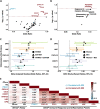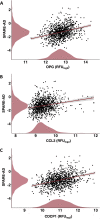Plasma proteins related to inflammatory diet predict future cognitive impairment
- PMID: 36737481
- PMCID: PMC10208977
- DOI: 10.1038/s41380-023-01975-7
Plasma proteins related to inflammatory diet predict future cognitive impairment
Erratum in
-
Correction to: Plasma proteins related to inflammatory diet predict future cognitive impairment.Mol Psychiatry. 2023 Apr;28(4):1610. doi: 10.1038/s41380-023-02007-0. Mol Psychiatry. 2023. PMID: 36849825 Free PMC article. No abstract available.
Abstract
Dysregulation of the immune system and dietary patterns that increase inflammation can increase the risk for cognitive decline, but the mechanisms by which inflammatory nutritional habits may affect the development of cognitive impairment in aging are not well understood. To determine whether plasma proteins linked to inflammatory diet predict future cognitive impairment, we applied high-throughput proteomic assays to plasma samples from a subset (n = 1528) of Women's Health Initiative Memory Study (WHIMS) participants (mean [SD] baseline age, 71.3 [SD 3.8] years). Results provide insights into how inflammatory nutritional patterns are associated with an immune-related proteome and identify a group of proteins (CXCL10, CCL3, HGF, OPG, CDCP1, NFATC3, ITGA11) related to future cognitive impairment over a 14-year follow-up period. Several of these inflammatory diet proteins were also associated with dementia risk across two external cohorts (ARIC, ESTHER), correlated with plasma biomarkers of Alzheimer's disease (AD) pathology (Aβ42/40) and/or neurodegeneration (NfL), and related to an MRI-defined index of neurodegenerative brain atrophy in a separate cohort (BLSA). In addition to evaluating their biological relevance, assessing their potential role in AD, and characterizing their immune-tissue/cell-specific expression, we leveraged published RNA-seq results to examine how the in vitro regulation of genes encoding these candidate proteins might be altered in response to an immune challenge. Our findings indicate how dietary patterns with higher inflammatory potential relate to plasma levels of immunologically relevant proteins and highlight the molecular mediators which predict subsequent risk for age-related cognitive impairment.
© 2023. The Author(s).
Conflict of interest statement
Supported in part by a grant from Fujirebio Diagnostics Inc awarded to AM. All other authors have no conflicts of interest to declare.
Figures





References
-
- Franceschi C, Campisi J. Chronic Inflammation (Inflammaging) and Its Potential Contribution to Age-Associated Diseases. J Gerontology. 2014;69:S4–S9. - PubMed
Publication types
MeSH terms
Substances
Grants and funding
- Z99 AG999999/ImNIH/Intramural NIH HHS/United States
- U01 HL096917/HL/NHLBI NIH HHS/United States
- RF1 AG079149/AG/NIA NIH HHS/United States
- 75N92021D00005/WH/WHI NIH HHS/United States
- 75N92022D00003/HL/NHLBI NIH HHS/United States
- 75N92021D00003/WH/WHI NIH HHS/United States
- 75N92022D00004/HL/NHLBI NIH HHS/United States
- R01 HL153178/HL/NHLBI NIH HHS/United States
- U01 HL096814/HL/NHLBI NIH HHS/United States
- R01 AG049953/AG/NIA NIH HHS/United States
- U01 HL096899/HL/NHLBI NIH HHS/United States
- 75N92022D00001/HL/NHLBI NIH HHS/United States
- 75N92021D00002/HL/NHLBI NIH HHS/United States
- P30 AG066507/AG/NIA NIH HHS/United States
- 75N92021D00001/HL/NHLBI NIH HHS/United States
- U01 HL096812/HL/NHLBI NIH HHS/United States
- 75N92022D00002/HL/NHLBI NIH HHS/United States
- K23 AG064122/AG/NIA NIH HHS/United States
- U01 HL096902/HL/NHLBI NIH HHS/United States
- 75N92021D00004/WH/WHI NIH HHS/United States
- 75N92022D00005/HL/NHLBI NIH HHS/United States
- R01 HL134320/HL/NHLBI NIH HHS/United States
LinkOut - more resources
Full Text Sources
Medical
Research Materials
Miscellaneous

